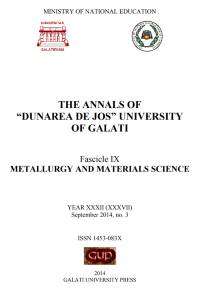Effect of an Oxy-Sulphide Inoculant Enhancer on Graphite Parameters in the Mould Inoculated Compacted Graphite Cast Iron
Abstract
In compacted/vermicular graphite cast iron production, inoculation is applied to limit the formation of carbides, but usually this treatment also promotes nodular graphite with improved nodularity. The main objective of the present paper is to examine the graphite phase characteristics in these irons, as affected by different in the mould inoculation variants, for resin sand mould castings. Graphite shape factors illustrate the loss of compactness of the graphite particles in the surface layer of the casting and its variation with cooling rate changes, especially with the circularity expression. In the surface layer, up to 0.5 mm from the cast surface, inoculation increased graphite nodularity, with the performance of the inoculant enhancer alloy [OS-IE] treated iron also promoting a high nodularity through the section of casting. A specific effect of inoculation with this alloy is the formation of a high number of small graphite nodules, which is accompanied by higher nodularity and the highest levels for the circularity and sphericity shape factors. Inoculation with the (Ca+OS-IE) dual addition led to the highest compacted/vermicular graphite formation sensitivity, with limited nodular graphite formation.
Downloads
References
[2]. Skaland T. - Nucleation Mechanism in Ductile Iron, Proceedings of AFS Conference on Cast Iron Inoculation, Schaumburg, sept. 2005, p.13-30.
[3]. Chisamera M., Riposan I. Barstow M. - The Importance of Sulphur to Control Graphite Nucleation in Cast Iron, AFS Inoculation Conference, April 1998, Chicago, USA, paper no. 3.
[4]. Lalich M. J., Hitchings J. R. - Characterization of Inclusions as Nuclei for Spheroidal Graphite in Ductile Cast Iron, AFS Trans., 1976, vol. 44, p 653-664.
[5]. Thielman T. - Zur Wirkung van Spurenelementen in Gusseisen mit Kugelgraphit, Giessereitechnik, 1970, 1, p. 16-24.
[6]. Xiaogan H., Nodular iron surface deterioration due to PTSA in resin, AFS Trans., 1992, vol. 100, p. 9-15.
[7]. Chisamera M., Riposan I., Ivan N., Stan S. - No-Bake Mould Iron Casting Skin Management – Effect of Magnesium Residual and Mould Coating, Proc. of the 71st World Foundry Congress, May 2014, Bilbao, Spain.
[8]. Riposan I., Chisamera M., Stan S. - Control of Surface Graphite Degeneration in Ductile Iron for Windmill Applications, Int. J. Metalcasting, 2013, 7 (1), p.9-20.
[9]. Ivan N., Chisamera M., Riposan I. - Mg-bearing coating of resin sand – PTSA moulds to control graphite degeneration in the surface layer of ductile iron castings, Mat. Sci. Techn., 2012, 28 (11), p. 1246-1253.



